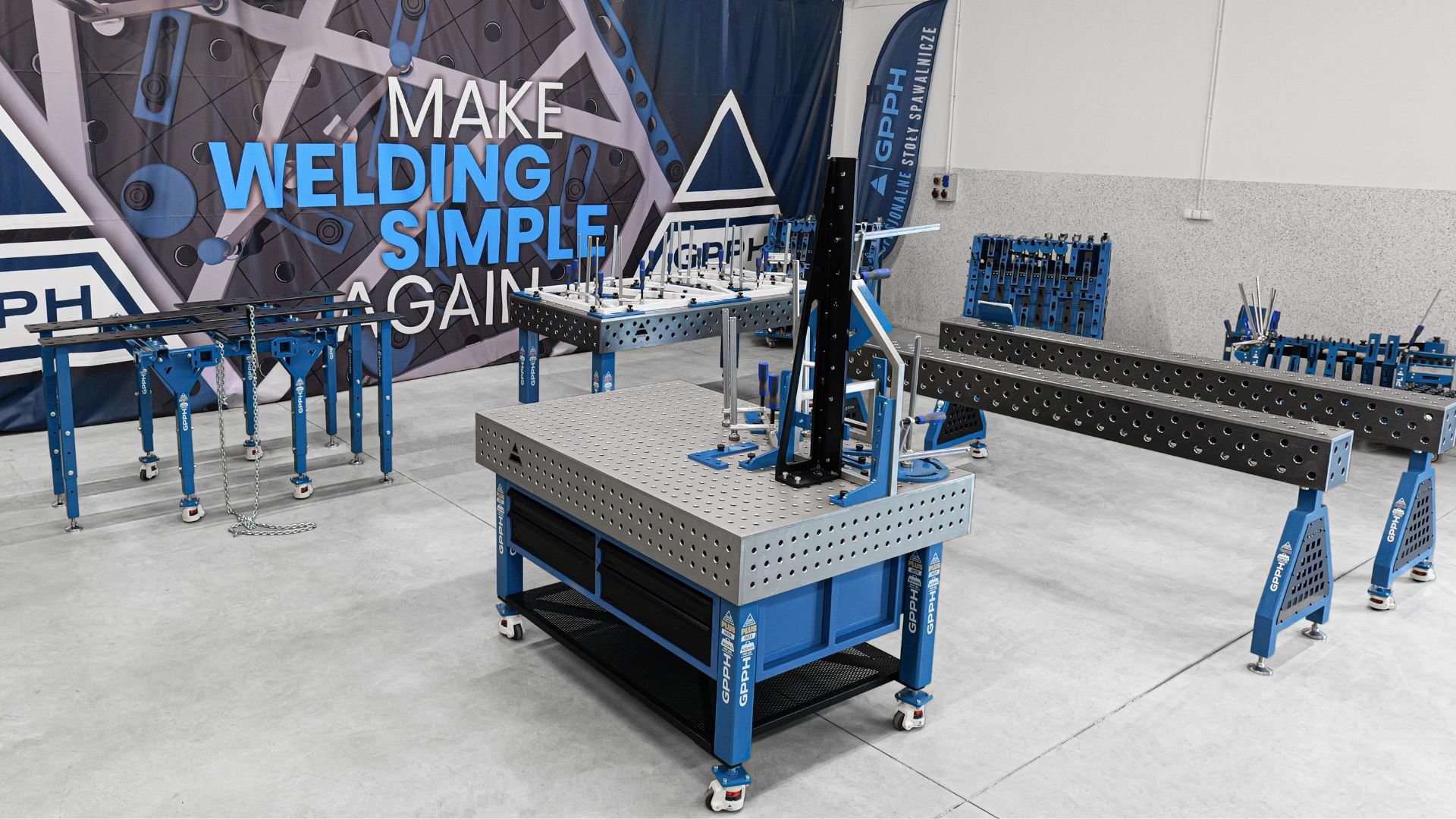Schweißen ist ein geschickter Beruf, der Präzision, Übung und die richtige Ausrüstung erfordert. Anfängern bietet ein Schweißtisch einen stabilen und zuverlässigen Arbeitsplatz, der das Lernen und die Entwicklung von Fähigkeiten fördert. Dieser Leitfaden behandelt die grundlegenden Fertigkeiten und ersten Schritte für Anfänger, die an einem Schweißtisch arbeiten, und bietet Einblicke in wichtige Techniken und Tipps für den Einstieg.
Einführung in das Schweißen auf einem Schweißtisch
Ein Schweißtisch ist eine flache, stabile Fläche, die speziell für Schweißarbeiten konzipiert ist. Er bietet eine sichere und verstellbare Plattform für die Aufnahme von Werkstücken und gewährleistet Präzision und Sicherheit beim Schweißen. Hochwertige Schweißtische, wie sie die GPPH-Gruppe herstellt, sind mit ihren modularen Vorrichtungen und präzisen Oberflächen sowohl für Anfänger als auch für erfahrene Schweißer geeignet. Entdecken Sie hier die hochwertigen Schweißtische der GPPH-Gruppe.
Grundfertigkeiten für Schweißanfänger
- Verständnis der Schweißarten: Der erste Schritt beim Schweißen besteht darin, die verschiedenen Arten von Schweißverfahren wie MIG (Metall-Inert-Gas), WIG (Wolfram-Inert-Gas) und Stangenschweißen zu verstehen. Jede Art hat ihre eigenen Anwendungen, Vorteile und Techniken.
- Sicherheit geht vor: Beim Schweißen treten hohe Temperaturen, UV-Licht und gefährliche Dämpfe auf. Tragen Sie immer eine geeignete persönliche Schutzausrüstung (PSA), einschließlich eines Schweißhelms mit entsprechender Tönung, feuerfester Handschuhe, langärmeliger Hemden und einer Schutzbrille.
- Lesen von Blaupausen und Schaltplänen: Das Lesen und Interpretieren von Bauplänen und Schweißplänen ist von entscheidender Bedeutung. Diese Dokumente enthalten detaillierte Anweisungen zu den Schweißnahtarten, Positionen und Spezifikationen, die für ein Projekt erforderlich sind.
- Vorbereitung des Materials: Reinigen Sie die Metalloberflächen, um Schmutz, Rost oder Öl zu entfernen. Eine ordnungsgemäße Vorbereitung gewährleistet eine bessere Schweißqualität und verhindert eine Verunreinigung des Schweißbads.
Erste Schritte auf dem Schweisstisch
- Einrichten des Schweißtisches: Stellen Sie den Schweißtisch an einem gut belüfteten Ort auf, um das Einatmen schädlicher Dämpfe zu vermeiden. Vergewissern Sie sich, dass der Tisch eben und sicher steht, um Bewegungen während des Schweißens zu vermeiden.
- Sichern von Werkstücken: Verwenden Sie Zwingen und Vorrichtungen, um die Werkstücke fest zu fixieren. Die Schweißtische der GPPH-Gruppe sind mit modularen Vorrichtungen ausgestattet, die eine präzise und sichere Positionierung der Materialien ermöglichen. Diese Einrichtung ist entscheidend für die Genauigkeit und Stabilität beim Schweißen.
- Einstellen der Schweißmaschine: Richten Sie Ihr Schweißgerät entsprechend der Art des Schweißens ein, die Sie durchführen. Stellen Sie Parameter wie Spannung, Stromstärke und Drahtvorschubgeschwindigkeit je nach Dicke und Art des Metalls ein. Die richtigen Einstellungen sind entscheidend für starke, saubere Schweißnähte.
- Übung macht den Meister: Beginnen Sie mit Übungsschweißungen an Altmetall, um ein Gefühl für den Prozess zu bekommen. Konzentrieren Sie sich darauf, den Schweißbrenner zu kontrollieren, eine konstante Geschwindigkeit beizubehalten und eine gleichmäßige Schweißnaht zu erzielen.
Grundlegende Schweißtechniken
- Heftschweißen: Beginnen Sie mit dem Zusammenschweißen der Teile. Heftschweißungen sind kleine Schweißnähte, die die Werkstücke an ihrem Platz halten und verhindern, dass sie sich während des endgültigen Schweißvorgangs bewegen.
- Stoßfugen: Dies ist eine gängige Schweißtechnik, bei der zwei Metallteile Kante an Kante miteinander verbunden werden. Vergewissern Sie sich, dass die Kanten ausgerichtet sind und verwenden Sie Klemmen, um sie zu fixieren. Führen Sie die Schweißnaht mit ruhiger Hand und gleichmäßiger Geschwindigkeit entlang der Naht aus.
- Kehlnähte: Kehlnähte verbinden zwei Metallteile in einem rechten Winkel. Diese Art von Schweißnaht wird häufig zum Schweißen von Metallstrukturen und Rahmen verwendet. Positionieren Sie die Teile sicher und führen Sie die Schweißraupe entlang der Naht, um ein gutes Eindringen und einen glatten Abschluss zu gewährleisten.
- Schweißraupensteuerung: Üben Sie die Beibehaltung einer konstanten Lichtbogenlänge und Fahrgeschwindigkeit. Die gleichmäßige Steuerung des Schweißbrenners gewährleistet gleichmäßige Schweißraupen und verringert die Wahrscheinlichkeit von Fehlern.
Gemeinsame Herausforderungen und Lösungen
- Schweißspritzer: Übermäßige Schweißspritzer können durch die Einstellung der Schweißparameter und die Gewährleistung sauberer Arbeitsflächen minimiert werden. Anti-Spritzer-Sprays können auch dazu beitragen, die Ansammlung von Schweißspritzern auf dem Schweißtisch und den Werkstücken zu reduzieren.
- Verzerrung: Die beim Schweißen entstehende Hitze kann dazu führen, dass sich das Metall verzieht oder verformt. Um dies zu verhindern, sollten Sie die Teile mit Klemmen fixieren und in einer Reihenfolge schweißen, die die Hitze gleichmäßig verteilt. Auch das Vorwärmen des Metalls kann das Risiko einer Verformung verringern.
- Porosität: Porosität in Schweißnähten wird durch eingeschlossene Gase verursacht. Sorgen Sie für eine ausreichende Schutzgasabdeckung und reinigen Sie die Metalloberflächen gründlich, um Verunreinigungen zu vermeiden. Die Anpassung der Gasdurchflussmenge kann ebenfalls zur Verringerung der Porosität beitragen.
- Knacken: Risse in Schweißnähten können durch unsachgemäße Schweißtechniken oder inkompatible Materialien entstehen. Verwenden Sie den richtigen Zusatzwerkstoff und wärmen Sie dickere Materialien vor, um das Risiko von Rissen zu verringern. Halten Sie eine gleichmäßige, kontrollierte Schweißgeschwindigkeit ein, um eine feste Schweißnaht zu gewährleisten.
Schlussfolgerung
Das Schweißen auf einem Schweißtisch bietet Anfängern eine stabile und effiziente Plattform zur Entwicklung ihrer Fähigkeiten. Wenn man diese grundlegenden Schritte und Techniken befolgt, können auch Anfänger starke, qualitativ hochwertige Schweißnähte erzielen. Die Investition in einen hochwertigen Schweißtisch, wie z. B. von GPPH Group, bietet eine zuverlässige und präzise Grundlage für jedes Schweißprojekt. Besuchen Sie die Website der GPPH-Gruppe um ihr Angebot an innovativen Schweißtischen und Zubehör zu erkunden.
Durch die Beherrschung dieser ersten Fertigkeiten und die Überwindung gängiger Herausforderungen können Anfänger eine solide Grundlage für das Schweißen schaffen, die den Weg für fortgeschrittenere Techniken und komplexe Projekte ebnet. Mit etwas Übung, Liebe zum Detail und der richtigen Ausrüstung kann jeder das Schweißen auf einem Schweißtisch erlernen.

